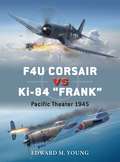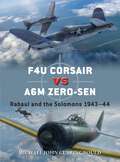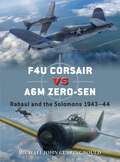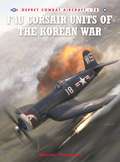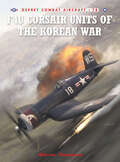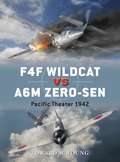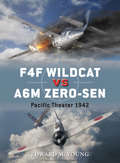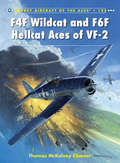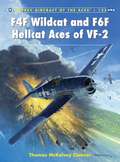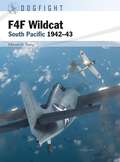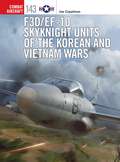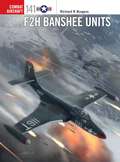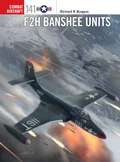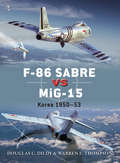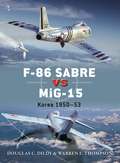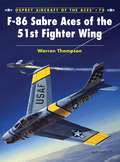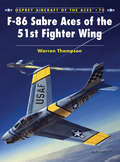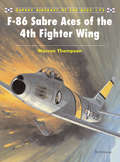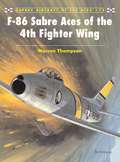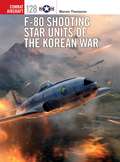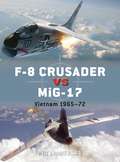- Table View
- List View
F4U Corsair vs Ki-84 "Frank†?: Pacific Theater 1945 (Duel #73)
by Jim Laurier Gareth Hector Edward M. YoungThe Vought Corsair was the first American single-engined fighter to exceed 400 mph and establish dominance over the legendary Mitsubishi Type Zero-sen. The Ki-84 Hayate was introduced by the Japanese specifically to counter this growing American dominance of the skies over the Pacific. Built in greater numbers than any other late war Japanese fighter, nearly 3000 were completed between 1944 and 1945. This volume examines the clashes between the Corsair and Ki-84 in the closing stages of the war, revealing how Corsair pilots had to adapt their techniques and combat strategies to adapt to these newer types. It also reveals how the kill rate was largely driven by the reduced quality of fighter pilots after the high casualty rates inflicted on the Japanese air force during the air battles over the Solomon Islands.
F4U Corsair vs Ki-84 "Frank†?: Pacific Theater 1945 (Duel #73)
by Jim Laurier Gareth Hector Edward M. YoungThe Vought Corsair was the first American single-engined fighter to exceed 400 mph and establish dominance over the legendary Mitsubishi Type Zero-sen. The Ki-84 Hayate was introduced by the Japanese specifically to counter this growing American dominance of the skies over the Pacific. Built in greater numbers than any other late war Japanese fighter, nearly 3000 were completed between 1944 and 1945. This volume examines the clashes between the Corsair and Ki-84 in the closing stages of the war, revealing how Corsair pilots had to adapt their techniques and combat strategies to adapt to these newer types. It also reveals how the kill rate was largely driven by the reduced quality of fighter pilots after the high casualty rates inflicted on the Japanese air force during the air battles over the Solomon Islands.
F4U Corsair versus A6M Zero-sen: Rabaul and the Solomons 1943–44 (Duel)
by Michael John ClaringbouldThe aerial clashes between the iconic Corsair and Zero-sen translated into a contest of speed and altitude for the former, versus the latter's outstanding agility and range.Whilst the F4U Corsair eventually proved to be a superior fighter in Pacific operations, its introduction into combat in this theatre initially demonstrated its weaknesses. Indeed, the 'Saint Valentine's Day Massacre' debacle showcased exemplary Zero-sen fighter tactics, and American losses were of sufficient magnitude that further daylight missions toward Bougainville were discontinued until Allied fighter tactics could be improved. As a result, for the next two months the Corsair's combat results were much subdued. Indeed, the F4U only became a superb fighter when both its pilots and their commanders worked out how to deploy the gull-wing design effectively. Optimum circumstances for effective engagement did not always occur, and the Zero-sen remained effective against the Corsair until February 1944 in the South Pacific, after which all IJNAF fighter units vacated Rabaul. This book closely examines these two different fighters in the Solomons/Rabaul theatre, and the unique geographic conditions which shaped their deployment and effectiveness. It contains rare photographs and digital artwork that accurately showcases and aligns combats of both types in-theatre with unprecedented accuracy. Both sides vastly over-claimed. With full access to IJNAF and US Navy/US Marine Corps records, these numbers will be presented accurately.
F4U Corsair versus A6M Zero-sen: Rabaul and the Solomons 1943–44 (Duel)
by Michael John ClaringbouldThe aerial clashes between the iconic Corsair and Zero-sen translated into a contest of speed and altitude for the former, versus the latter's outstanding agility and range.Whilst the F4U Corsair eventually proved to be a superior fighter in Pacific operations, its introduction into combat in this theatre initially demonstrated its weaknesses. Indeed, the 'Saint Valentine's Day Massacre' debacle showcased exemplary Zero-sen fighter tactics, and American losses were of sufficient magnitude that further daylight missions toward Bougainville were discontinued until Allied fighter tactics could be improved. As a result, for the next two months the Corsair's combat results were much subdued. Indeed, the F4U only became a superb fighter when both its pilots and their commanders worked out how to deploy the gull-wing design effectively. Optimum circumstances for effective engagement did not always occur, and the Zero-sen remained effective against the Corsair until February 1944 in the South Pacific, after which all IJNAF fighter units vacated Rabaul. This book closely examines these two different fighters in the Solomons/Rabaul theatre, and the unique geographic conditions which shaped their deployment and effectiveness. It contains rare photographs and digital artwork that accurately showcases and aligns combats of both types in-theatre with unprecedented accuracy. Both sides vastly over-claimed. With full access to IJNAF and US Navy/US Marine Corps records, these numbers will be presented accurately.
F4U Corsair Units of the Korean War (Combat Aircraft)
by Mark Styling Warren ThompsonThis book tells the story of the 26 US Navy Squadrons, most of which were carrier based, and the six Marine Corps F-4 squadrons that flew combat missions against the North Koreans. Drawing from a vast repository of personal interviews with F-4 pilots, the author paints a harrowing picture of the deadly combat of this often forgotten air war. Included in this volume is the story of Lt Guy Bordelon, the US Navy's sole ace of the Korean War, who flew an F4U-5N night-fighter against the night raiders sent up by the Korean Air Force. Supporting the text is a vast number of previously unpublished private photographs that bring the stories of these pilots to life. Finally the book contains extensive appendices that detail every unit deployment by carrier, air group, Corsair model and tail code, as well as detailed lists noting every Corsair lost in the war.
F4U Corsair Units of the Korean War (Combat Aircraft)
by Warren ThompsonThis book tells the story of the 26 US Navy Squadrons, most of which were carrier based, and the six Marine Corps F-4 squadrons that flew combat missions against the North Koreans. Drawing from a vast repository of personal interviews with F-4 pilots, the author paints a harrowing picture of the deadly combat of this often forgotten air war. Included in this volume is the story of Lt Guy Bordelon, the US Navy's sole ace of the Korean War, who flew an F4U-5N night-fighter against the night raiders sent up by the Korean Air Force. Supporting the text is a vast number of previously unpublished private photographs that bring the stories of these pilots to life. Finally the book contains extensive appendices that detail every unit deployment by carrier, air group, Corsair model and tail code, as well as detailed lists noting every Corsair lost in the war.
F4F Wildcat vs A6M Zero-sen: Pacific Theater 1942 (Duel #54)
by Jim Laurier Gareth Hector Edward M. YoungThe Grumman F4F Wildcat and the Mitsubishi A6M Zero-sen were contemporaries, although designed to very different requirements. The Wildcat, ruggedly built to survive the rigors of carrier operations, was the best carrier fighter the US Navy had available when the USA entered World War II, and it remained the principal fighter for the US Navy and the US Marine Corps until 1942–43. With a speed greater than 300mph, exceptional manoeuvrability, long range, and an impressive armament the slick Zero-sen could out-perform any Allied fighter in 1941–42. The battles between the Wildcat and the Zero-sen during 1942 represent a classic duel in which pilots flying a nominally inferior fighter successfully developed air-combat tactics that negated the strengths of their opponent.
F4F Wildcat vs A6M Zero-sen: Pacific Theater 1942 (Duel #54)
by Jim Laurier Gareth Hector Edward M. YoungThe Grumman F4F Wildcat and the Mitsubishi A6M Zero-sen were contemporaries, although designed to very different requirements. The Wildcat, ruggedly built to survive the rigors of carrier operations, was the best carrier fighter the US Navy had available when the USA entered World War II, and it remained the principal fighter for the US Navy and the US Marine Corps until 1942–43. With a speed greater than 300mph, exceptional manoeuvrability, long range, and an impressive armament the slick Zero-sen could out-perform any Allied fighter in 1941–42. The battles between the Wildcat and the Zero-sen during 1942 represent a classic duel in which pilots flying a nominally inferior fighter successfully developed air-combat tactics that negated the strengths of their opponent.
F4F Wildcat and F6F Hellcat Aces of VF-2 (Aircraft of the Aces #125)
by Jim Laurier Thomas McKelvey Cleaver Mr Mark PostlethwaiteThe first VF-2 was a prewar unit that had been dubbed the 'hottest outfit afloat' due to the skill of their non-commissioned pilots. This first unit only saw combat at the Battle of the Coral Sea, although VF-2 pilots flying Grumman F4F Wildcats were able to rack up 17 claims there during the bitter 48-hour period of fighting. The second 'Fighting Two' was armed with the new Grumman F6F-3 Hellcat fighter. Arriving in Hawaii in October 1943, the squadron so impressed Cdr Edward H 'Butch' O'Hare, the Medal of Honor-winning first US Navy ace of World War 2, that he requested the squadron replace VF-6 in his CAG-6 aboard USS Enterprise. No unit US Navy unit created more aces than VF-2, whose pilots went into action over the Carolines, Marianas, Guam, Iwo Jima and the Battle of the Philippine Sea. Using exquisite photographs and first-hand accounts from the elite fliers themselves, this volume tells the story of the ace pilots who comprised the original VF-2 and the second.
F4F Wildcat and F6F Hellcat Aces of VF-2 (Aircraft of the Aces)
by Jim Laurier Mark Postlethwaite Thomas McKelvey CleaverThe first VF-2 was a prewar unit that had been dubbed the 'hottest outfit afloat' due to the skill of their non-commissioned pilots. This first unit only saw combat at the Battle of the Coral Sea, although VF-2 pilots flying Grumman F4F Wildcats were able to rack up 17 claims there during the bitter 48-hour period of fighting. The second 'Fighting Two' was armed with the new Grumman F6F-3 Hellcat fighter. Arriving in Hawaii in October 1943, the squadron so impressed Cdr Edward H 'Butch' O'Hare, the Medal of Honor-winning first US Navy ace of World War 2, that he requested the squadron replace VF-6 in his CAG-6 aboard USS Enterprise. No unit US Navy unit created more aces than VF-2, whose pilots went into action over the Carolines, Marianas, Guam, Iwo Jima and the Battle of the Philippine Sea. Using exquisite photographs and first-hand accounts from the elite fliers themselves, this volume tells the story of the ace pilots who comprised the original VF-2 and the second.
F4F Wildcat: South Pacific 1942–43 (Dogfight #9)
by Edward M. YoungThis book examines the role of the Grumman F4F Wildcat, the US Navy's standard carrier fighter at the start of the Pacific War, and its clashes against the Imperial Japanese Naval Air Force's Mitsubishi A6M Zero-sen.The US Navy went to war in December 1941 with the tubby Wildcat, the first of Grumman's famed 'cats', as its principal carrier fighter. Ruggedly built and well armed, the F4F's performance was inferior to the Japanese Zero-sen, yet in the carrier battles of 1942 between the US Navy and the IJN the Wildcat pilots more than held their own against some of the finest naval aviators in the world. Many of the Wildcat pilots that saw action in the South Pacific comprised what respected naval historian John Lundstrom has called the 'First Team' – the small group of highly trained prewar pilots who manned the bulk of the US Navy's carrier fighter squadrons. Illustrated with specially commissioned artwork, including armament views and ribbon diagrams, the book examines the carrier battles that took place in August and October in the South Pacific around the first American offensive of the war – the amphibious assault on the island of Guadalcanal, and the actions of the Wildcat in combat with IJN carrier aircraft. The key combat actions are described and accompanied with rare and original photographs and diagrams, as are the training and tactics that contributed to the Wildcat's success.
F4F Wildcat: South Pacific 1942–43 (Dogfight #9)
by Edward M. YoungThis book examines the role of the Grumman F4F Wildcat, the US Navy's standard carrier fighter at the start of the Pacific War, and its clashes against the Imperial Japanese Naval Air Force's Mitsubishi A6M Zero-sen.The US Navy went to war in December 1941 with the tubby Wildcat, the first of Grumman's famed 'cats', as its principal carrier fighter. Ruggedly built and well armed, the F4F's performance was inferior to the Japanese Zero-sen, yet in the carrier battles of 1942 between the US Navy and the IJN the Wildcat pilots more than held their own against some of the finest naval aviators in the world. Many of the Wildcat pilots that saw action in the South Pacific comprised what respected naval historian John Lundstrom has called the 'First Team' – the small group of highly trained prewar pilots who manned the bulk of the US Navy's carrier fighter squadrons. Illustrated with specially commissioned artwork, including armament views and ribbon diagrams, the book examines the carrier battles that took place in August and October in the South Pacific around the first American offensive of the war – the amphibious assault on the island of Guadalcanal, and the actions of the Wildcat in combat with IJN carrier aircraft. The key combat actions are described and accompanied with rare and original photographs and diagrams, as are the training and tactics that contributed to the Wildcat's success.
F3D/EF-10 Skyknight Units of the Korean and Vietnam Wars (Combat Aircraft)
by Joe CopalmanThe Douglas F3D Skyknight was an early but effective attempt at combining new technologies together in a lethal package capable of shipboard operation. Whereas most fighters relied on speed and maneuverability, the portly, straight-winged F3D relied on three radars, four 20mm cannon, and – most importantly – darkness. Having first flown in March 1948, the Skyknight's first taste of war came in September 1952, when Marine Night Fighter Squadron 513 [VMF(N)-513] deployed to Korea. The most important job assigned to VMF(N)-513 was the escorting of USAF B-29 bombers over northern Korea. Whereas Chinese and North Korean MiG-15s relied on ground-controlled intercept radar for steering guidance into firing positions, the F3D, with its own onboard radars, was autonomously lethal – it could detect, track and target MiGs all on its own. Skyknight crews ended the Korean War with six nocturnal kills in exchange for one combat loss.After the war, 35 Skyknights were converted into electronic warfare (EW) aircraft. As US air operations over North Vietnam intensified in early 1965, the need for a tactical EW jet to provide electronic countermeasures (ECM) protection to accompany strike packages north became apparent. For all of its early effectiveness over North Vietnam, the proliferation of radar-guided guns and missiles began to erode the advantage created by EF-10 escort support, which flew its last combat mission in October 1969.This highly illustrated volume explores the F3D Skynights and their deployment during the Korean and Vietnam wars, using first-hand accounts from aircrew, original photographs and 30 profile artworks to explore their key roles as an escort aircraft and electronic warfare aircraft.
F3D/EF-10 Skyknight Units of the Korean and Vietnam Wars (Combat Aircraft)
by Joe CopalmanThe Douglas F3D Skyknight was an early but effective attempt at combining new technologies together in a lethal package capable of shipboard operation. Whereas most fighters relied on speed and maneuverability, the portly, straight-winged F3D relied on three radars, four 20mm cannon, and – most importantly – darkness. Having first flown in March 1948, the Skyknight's first taste of war came in September 1952, when Marine Night Fighter Squadron 513 [VMF(N)-513] deployed to Korea. The most important job assigned to VMF(N)-513 was the escorting of USAF B-29 bombers over northern Korea. Whereas Chinese and North Korean MiG-15s relied on ground-controlled intercept radar for steering guidance into firing positions, the F3D, with its own onboard radars, was autonomously lethal – it could detect, track and target MiGs all on its own. Skyknight crews ended the Korean War with six nocturnal kills in exchange for one combat loss.After the war, 35 Skyknights were converted into electronic warfare (EW) aircraft. As US air operations over North Vietnam intensified in early 1965, the need for a tactical EW jet to provide electronic countermeasures (ECM) protection to accompany strike packages north became apparent. For all of its early effectiveness over North Vietnam, the proliferation of radar-guided guns and missiles began to erode the advantage created by EF-10 escort support, which flew its last combat mission in October 1969.This highly illustrated volume explores the F3D Skynights and their deployment during the Korean and Vietnam wars, using first-hand accounts from aircrew, original photographs and 30 profile artworks to explore their key roles as an escort aircraft and electronic warfare aircraft.
F2H Banshee Units (Combat Aircraft)
by Rick BurgessA fully illustrated study of the extraordinarily successful early-generation jet, the F2H Banshee, a frontline aircraft that served with 27 US Navy and US Marine Corps squadrons and three Royal Canadian Navy (RCN) squadrons.The F2H Banshee was an extraordinarily successful early-generation jet that outlasted both contemporary and more modern fighter types on the decks of the US Navy's aircraft carriers in the 1950s. It served in a variety of roles, undertaking fighter, strike fighter, night-fighter, nuclear strike and photo-reconnaissance missions. The Banshee was a frontline aircraft for more than a decade in an era when jet fighters came and went with relatively short service careers. This book examines the entire service life of the F2H in the service of the US Navy, US Marine Corps and the RCN. Initially created as a replacement aircraft for McDonnell's pioneering FH1 Phantom, the F2H served in the Korean War as a strike fighter, close air support aircraft, B29 escort, and photoreconnaissance aircraft, including the latter's forays over the Soviet Union and China. Post service in Korea, the Banshee served as a carrier based nuclear strike aircraft, followed by its service as a defensive fighter for antisubmarine aircraft carriers. Filled with first-hand accounts and rare colour photographs, this is the engrossing story of the F2H Banshee, exploring its variety of roles in service and detailing the technology development that improved the aircraft's capabilities over time.
F2H Banshee Units (Combat Aircraft)
by Rick BurgessA fully illustrated study of the extraordinarily successful early-generation jet, the F2H Banshee, a frontline aircraft that served with 27 US Navy and US Marine Corps squadrons and three Royal Canadian Navy (RCN) squadrons.The F2H Banshee was an extraordinarily successful early-generation jet that outlasted both contemporary and more modern fighter types on the decks of the US Navy's aircraft carriers in the 1950s. It served in a variety of roles, undertaking fighter, strike fighter, night-fighter, nuclear strike and photo-reconnaissance missions. The Banshee was a frontline aircraft for more than a decade in an era when jet fighters came and went with relatively short service careers. This book examines the entire service life of the F2H in the service of the US Navy, US Marine Corps and the RCN. Initially created as a replacement aircraft for McDonnell's pioneering FH1 Phantom, the F2H served in the Korean War as a strike fighter, close air support aircraft, B29 escort, and photoreconnaissance aircraft, including the latter's forays over the Soviet Union and China. Post service in Korea, the Banshee served as a carrier based nuclear strike aircraft, followed by its service as a defensive fighter for antisubmarine aircraft carriers. Filled with first-hand accounts and rare colour photographs, this is the engrossing story of the F2H Banshee, exploring its variety of roles in service and detailing the technology development that improved the aircraft's capabilities over time.
F-86 Sabre vs MiG-15: Korea 1950–53 (Duel)
by Jim Laurier Doug Dildy Mr Warren Thompson Wiek LuijkenAs the routed North Korean People's Army (NKPA) withdrew into the mountainous reaches of their country and the People's Republic of China (PRC) funneled in its massive infantry formations in preparation for a momentous counter-offensive, both lacked adequate air power to challenge US and UN. Reluctantly, Josef Stalin agreed to provide the requisite air cover, introducing the superior swept-wing MiG-15 to counter the American's straight-wing F-80 jets. This in turn prompted the USAF to deploy its very best – the F-86A Sabre – to counter this threat. Thus began a two-and-a-half-year struggle in the skies known as "MiG Alley.†? In this period, the unrelenting campaign for aerial superiority witnessed the introduction of successive models of these two revolutionary jets into combat. This meticulously researched study not only provides technical descriptions of the two types and their improved variants, complete with a "fighter pilot's assessment†? of these aircraft, but also chronicles the entire scope of their aerial duel in "MiG Alley†? by employing the recollections of the surviving combatants – including Russian, Chinese, and North Korean pilots – who participated.
F-86 Sabre vs MiG-15: Korea 1950–53 (Duel)
by Jim Laurier Doug Dildy Warren Thompson Wiek LuijkenAs the routed North Korean People's Army (NKPA) withdrew into the mountainous reaches of their country and the People's Republic of China (PRC) funneled in its massive infantry formations in preparation for a momentous counter-offensive, both lacked adequate air power to challenge US and UN. Reluctantly, Josef Stalin agreed to provide the requisite air cover, introducing the superior swept-wing MiG-15 to counter the American's straight-wing F-80 jets. This in turn prompted the USAF to deploy its very best – the F-86A Sabre – to counter this threat. Thus began a two-and-a-half-year struggle in the skies known as “MiG Alley.” In this period, the unrelenting campaign for aerial superiority witnessed the introduction of successive models of these two revolutionary jets into combat. This meticulously researched study not only provides technical descriptions of the two types and their improved variants, complete with a “fighter pilot's assessment” of these aircraft, but also chronicles the entire scope of their aerial duel in “MiG Alley” by employing the recollections of the surviving combatants – including Russian, Chinese, and North Korean pilots – who participated.
F-86 Sabre Aces of the 51st Fighter Wing (Aircraft of the Aces)
by Mark Styling Warren ThompsonThe 51st Fighter Wing initially flew the F-80C in the Korean War, but in 1951, the 51st brought in high-scoring World War 2 ace Colonel Francis Gabreski to assume command when it converted from the F-80 over to the newly arrived F-86E. His recruits included his elite 4th Wing pilots, and by the end of the war, the 51st had two pilots who achieved the status of "Double Ace†? as well as the highest scoring ace of the war, Joe McConnell. This book describes the 51st Wing's tenure with the Sabre that led to their high scoring sprees of 1953.
F-86 Sabre Aces of the 51st Fighter Wing (Aircraft of the Aces #70)
by Mark Styling Warren ThompsonThe 51st Fighter Wing initially flew the F-80C in the Korean War, but in 1951, the 51st brought in high-scoring World War 2 ace Colonel Francis Gabreski to assume command when it converted from the F-80 over to the newly arrived F-86E. His recruits included his elite 4th Wing pilots, and by the end of the war, the 51st had two pilots who achieved the status of "Double Ace†? as well as the highest scoring ace of the war, Joe McConnell. This book describes the 51st Wing's tenure with the Sabre that led to their high scoring sprees of 1953.
F-86 Sabre Aces of the 4th Fighter Wing (Aircraft of the Aces #72)
by Mark Styling Mr Warren ThompsonThe entry of the United State's premier jet interceptor into the Korean War was triggered by the ever-increasing presence of the Soviet-built MiG-15 south of the Yalu River. The possibility of the USAF losing air supremacy over the Korean Peninsula was unacceptable. The 4th Fighter Wing got the call for combat in Korea. They were made up of a combination of new pilots right out of jet training and the older combat veterans of World War II vintage. This combination of pilot types wrote and re-wrote the text books on jet warfare. Of the 40 jet aces that the war produced, the 4th Wing boasted 24 of them. This book details these incredible pilots and the planes they flew.
F-86 Sabre Aces of the 4th Fighter Wing (Aircraft of the Aces #72)
by Mark Styling Warren ThompsonThe entry of the United State's premier jet interceptor into the Korean War was triggered by the ever-increasing presence of the Soviet-built MiG-15 south of the Yalu River. The possibility of the USAF losing air supremacy over the Korean Peninsula was unacceptable. The 4th Fighter Wing got the call for combat in Korea. They were made up of a combination of new pilots right out of jet training and the older combat veterans of World War II vintage. This combination of pilot types wrote and re-wrote the text books on jet warfare. Of the 40 jet aces that the war produced, the 4th Wing boasted 24 of them. This book details these incredible pilots and the planes they flew.
F-80 Shooting Star Units of the Korean War (Combat Aircraft)
by Warren ThompsonBuilt within a 180-day time limit in 1943, the F-80 Shooting Star first saw service in Italy in the final year of World War 2, and consequently was sent to bases in the US, Europe and the Far East after VJ Day. It was the latter groups based in Japan that initially bore the brunt of the early fighting in Korea, engaging MiG-15s in the world's first jet-versus-jet combat. Flown principally by the 8th and 49th Fighter Bomber Wings, the F-80 served until the end of the war, completing an astonishing 98,515 combat sorties, shooting down 17 aircraft (including three of the vastly superior MiG-15s), dropping over 33,000 tons of bombs, and firing over 80,000 air-to-ground rockets. Aside from the fighter-bomber Shooting Stars, the ultra-rare, but heavily used, photo-reconnaissance RF-80A saw extensive use in the frontline in Korea as a replacement for the vulnerable RF-51D. Filled with first-hand accounts and rare colour photographs taken by the veterans themselves, this is the engrossing story of the pioneering F-80 Shooting Star.
F-80 Shooting Star Units of the Korean War (Combat Aircraft #128)
by Warren ThompsonBuilt within a 180-day time limit in 1943, the F-80 Shooting Star first saw service in Italy in the final year of World War 2, and consequently was sent to bases in the US, Europe and the Far East after VJ Day. It was the latter groups based in Japan that initially bore the brunt of the early fighting in Korea, engaging MiG-15s in the world's first jet-versus-jet combat. Flown principally by the 8th and 49th Fighter Bomber Wings, the F-80 served until the end of the war, completing an astonishing 98,515 combat sorties, shooting down 17 aircraft (including three of the vastly superior MiG-15s), dropping over 33,000 tons of bombs, and firing over 80,000 air-to-ground rockets. Aside from the fighter-bomber Shooting Stars, the ultra-rare, but heavily used, photo-reconnaissance RF-80A saw extensive use in the frontline in Korea as a replacement for the vulnerable RF-51D. Filled with first-hand accounts and rare colour photographs taken by the veterans themselves, this is the engrossing story of the pioneering F-80 Shooting Star.
F-8 Crusader vs MiG-17: Vietnam 1965-72 (Duel)
by Jim Laurier Peter Mersky Gareth HectorRevered by Naval Aviators as the 'last of the gunfighters' due to its quartet of Colt-Browning Mk 12 20 mm cannon, the F-8 Crusader enjoyed great success against VPAF MiG-17s during the Rolling Thunder campaign of 1966–68. But, the MiG-17's unequalled low-speed manoeuvrability, small size and powerful cannon armament meant that the American forces didn't have it all their own way. This fully illustrated book, featuring photographs, maps and battlescene artwork, reveals the tactics that were developed by pilots on both sides to give themselves the edge in air-to-air dogfights, allowing the reader to understand how the differing design and development doctrines played a part in combat.
